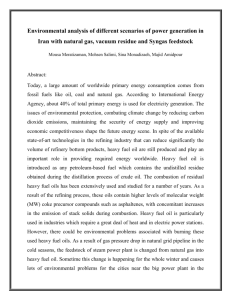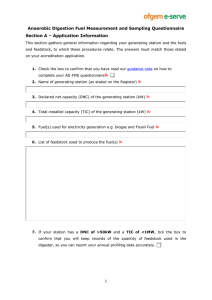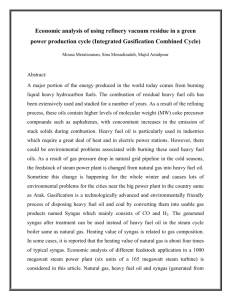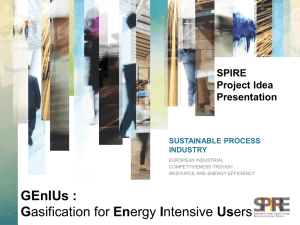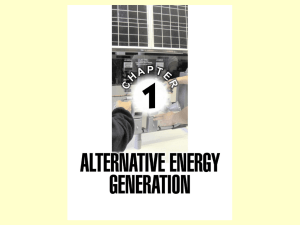advanced_conversion_technology_fmsq
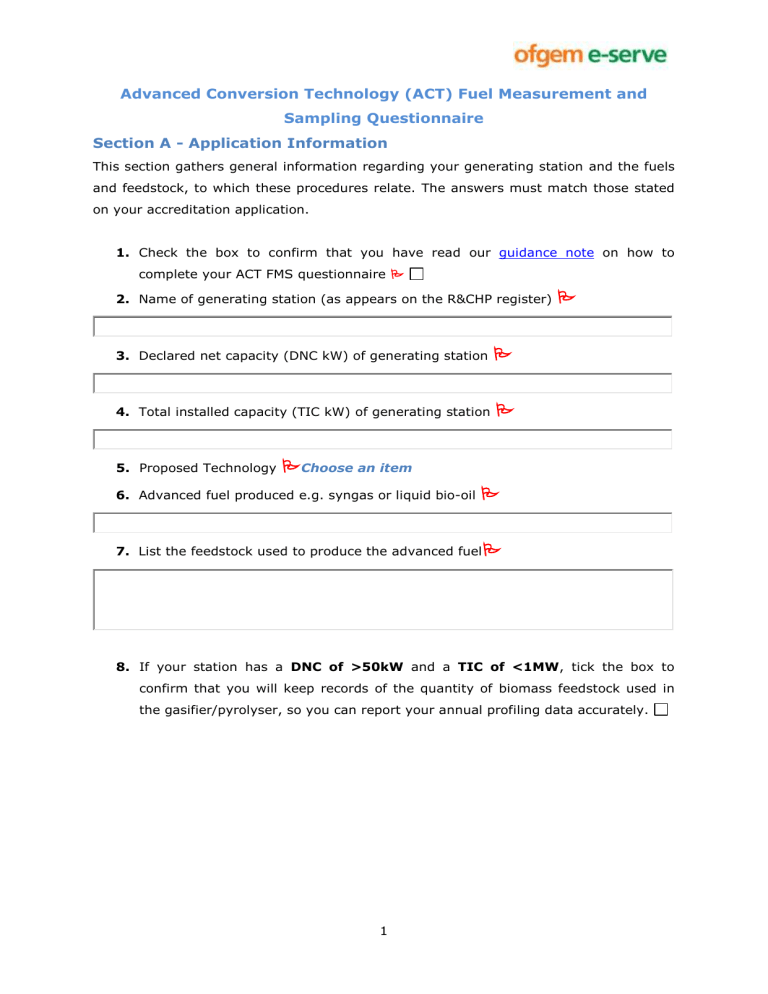
Advanced Conversion Technology (ACT) Fuel Measurement and
Sampling Questionnaire
Section A - Application Information
This section gathers general information regarding your generating station and the fuels and feedstock, to which these procedures relate. The answers must match those stated on your accreditation application.
1.
Check the box to confirm that you have read our guidance note on how to complete your ACT FMS questionnaire
2.
Name of generating station (as appears on the R&CHP register)
3.
Declared net capacity (DNC kW) of generating station
4.
Total installed capacity (TIC kW) of generating station
5.
Proposed Technology Choose an item
6.
Advanced fuel produced e.g. syngas or liquid bio-oil
7.
List the feedstock used to produce the advanced fuel
8.
If your station has a DNC of >50kW and a TIC of <1MW, tick the box to confirm that you will keep records of the quantity of biomass feedstock used in the gasifier/pyrolyser, so you can report your annual profiling data accurately.
1
Section B - Version History
This section should only be completed for any revisions made after the initial approval
of procedures has been given by Ofgem.
1.
Indicate the version number of these FMS procedures N.B. Rev 0 is the procedures as originally approved: Choose an item
2.
State the purpose of this latest revision and indicate the changes made (making reference to specific question numbers e.g. F7).
Section C – Fuel Classification
Please refer to table 1 in our guidance note on how to complete your ACT FMS questionnaire to see whether you need to complete this section, given your station size and fuel type. This section gathers information on whether you are applying a fuel classification with associated exemptions, this is to identify whether the feedstock/process is already accounted for in the Sustainability Criteria guidance . We suggest you read chapter 3 of this guidance to help you answer questions C1 and C2.
1.
Do you consider all feedstock stated in A7 to be products or co-products? Yes
If you have answered ‘No’ to C1, answer C2.
2.
Are feedstock that you do not consider to be products or co-products already identified in Appendix 3 of the Sustainability Reporting guidance? Choose an
item
If you have answered ‘No’ to C1 and C2, a member of the team will be in touch to discuss the classification.
2
Section D – Consignment Assessment and Tracking Sustainability
Information
For more information about this section, including whether you need to complete it given your station size and fuel type, please refer to our guidance note on how to complete your Standard FMS questionnaire.
Consignment Assessment
Questions D1-D7 help determine whether the advanced fuel(s) in A6 are single or multiple consignments, derived from feedstock with different sustainability characteristics.
1.
With reference to the sustainability characteristics listed in Chapter 6 of the
Sustainability Reporting guidance, do you consider each feedstock named in A7 to be a single consignment?
Choose Item
2.
If you have answered ‘No’ to D1, list the consignments that make up the feedstock given in A7
3.
If wood pellets are used as a feedstock at the station, do they contain binders?
Choose an item
If you have answered ‘Yes’ to D3, go to D4. If you have answered ‘No’ or ‘N/A’ to D3 skip to D5.
4.
Is the binder ≤2% by weight of any wood pellet consignment used at the station?
Choose an item
We require evidence to demonstate that binder is ≤ 2% by weight of any wood pellet consignment. If applicable, tick the box to confirm that you have provided this evidence
N.B. If binders contribute >2% of a wood pellet consignment’s weight, then the sustainability criteria of the binder will need to be reported on a consignment basis.
5.
Are feedstock mixed in the supply chain/before arriving at the generating station?
Choose an item
3
6.
If you answered ‘Yes’ to D5, which of the feedstock, listed in A7, are mixed in the supply chain/before arriving at the generating station? This includes mixing with fossil fuel.
7.
Are feedstock mixed at the generating station prior to gasification/pyrolysis?
Choose an item
8.
If you answered ‘Yes’ to D7, state which of the feedstock, listed in A7, are mixed at the generating station, including mixing with fossil fuel.
If you have answered ‘No’ to D5 and D7, or the feedstock that are mixed are part of the same feedstock consignment, go to Section E.
4
Tracking Sustainability Information
Questions D9 and D10 gather information on how you will will determine the quantity of each feedstock consignment used in the gasifier/pyrolyser where consignments are mixed.
9.
Which type of mass balance system do you use to determine the quantity of each consignment used at the generating station? Choose Item
10.
Explain how you will use a mass-balance system, including:
where in the supply chain and/or generating station the method will be used,
to which feedstock consignments it will apply,
how you will use the system to determine the quantity of each feedstock consignment used in a month.
5
Section E - Fossil Fuel Use
For more information about this section, please refer to our guidance note on how to complete your ACT FMS questionnaire.
1.
Is fossil fuel used at the generating station for any purpose?
Choose an item
If you have answered ‘Yes’ to question E1, then questions E2-E4 should also be answered. If you have answered ‘No’, go to Section F.
2.
I What fossil fuels are used at the generating station?
3.
Does the fossil fuel result in the generation of any of the generating station’s gross output? Choose an item
4.
If fossil fuel use does not result in generation, explain how you know this to be the case.
If fossil fuel will result in generation, questions E5 and E6 should be answered, otherwise go to section F.
5.
How will you determine the quantity of fossil fuel used in a month? State any equipment used and its accuracy (as a percentage or using units e.g. +/- X% or
X kg).
6
6.
How will you determine the GCV of fossil fuel used in a month? Make reference to any standards used to sample and test the fossil fuel for GCV.
7.
What monthly evidence will you send us to substantiate the quantity and GCV figures for fossil fuel? Provide an example as part of your submission.
Section F - Volume of advanced fuel used
For more information about this section, please refer to our guidance note on how to complete your ACT FMS questionnaire.
1.
How will you measure the volume of the advanced fuel used in a month? State the position that measurement is taken and unit of measurement. Also provide details of any equipment used e.g. a flow meter, and confirm its accuracy.
Section G - Determining the GCV of the advanced fuel
For more information about this section, please refer to our guidance note on how to complete your ACT FMS questionnaire.
Questions G2-G13 refer only to gaseous advanced fuel (syngas). If you are using a liquid advanced fuel (bio-oil) please answer G14.
1.
State the method used for measuring the GCV of the syngas Choose an item
If using an analyser, questions G2–G6 are compulsory.
7
2.
State the model of analyser to be installed and its accuracy e.g. +/- %.
3.
At what frequency is a gas sample extracted and sampled by the analyser?
4.
Check the appropriate box to confirm that:
the analyser is situated at the inlet of the generating station
you have emailed the staff member reviewing your FMS procedures a schematic diagram to show that the analyser is located at the inlet to the generating station
5.
Explain how you will measure the GCV at 25°C and 0.1 MPa 1 or if the measurement is taken at other conditions how you will normalise the GCV to these conditions.
6.
Will you use any alternative method of GCV sampling to verify the results from the analyser, such as bag samples? Provide details of the method (eg frequency of sampling, where the sample will be taken, how it will be extracted and what tests it will be subjected to).
1 Megapascals.
8
If using bag samples supported with a back calculation, questions G7–G13 are compulsory.
Bag Sampling
7.
What will be the total number of bag samples taken in a month, and at what intervals will samples be taken (eg weekly)?
8.
Who will extract the sample and how are they qualified to undertake sampling?
9.
What vessel or container will be used to capture the gas sample and how will it be stored prior to laboratory analysis?
10. Where will the samples will be analysed for GCV (eg will samples be sent to a laboratory or analysed in-house)? If using a laboratory state any accreditations it holds. Also state what test will be conducted on the sample to give a GCV, mentioning any relevant standards, and also how the result will be normalised to the following temperature and pressure conditions: 25°C and 0.1 MPa.
9
Back Calculation
11. What calculation will you use to to provide frequent GCV values for the advanced fuel ? You should outline the formula that is used, how the key input values are derived and the equipment used to measure them. For further information on this calculation consult Chapter 3 of the FMS guidance .
12.At what frequency are GCV values determined by the back-calculation?
13.
Check the appropriate box to confirm that:
bag sampling is performed at the inlet of the generating station
you have emailed the staff member reviewing your FMS procedures a schematic that shows the location at which bag samples are extracted from in relation to the generating station
For liquid advanced fuels question G14 is compulsory.
14.For liquid advanced fuels, outline the procedures to accurately determine the GCV of the advanced fuel on a monthly basis. Include information on the location and frequency of sampling, and any equipment used (including its accuracy).
10
For both liquid and gaseous advanced fuels, G15 is compulsory.
15.What monthly evidence you will send us to substantiate the average GCV of the advanced fuel in a given month? Provide an example as part of your submission.
Section H – Determining the qualifying percentage of the advanced fuel
For more information about this section, please refer to our guidance note on how to complete your ACT FMS questionnaire.
1.
Will the feedstock used to produce the advanced fuel contain any fossil derived contamination? Choose an item
If you have answered ‘Yes’ to H1, questions H2 – H7 and sub sections HA – HD should be completed. If there is no fossil derived contamination present in your feedstock this is not required and you can progress directly to Section I. However, we will require a feedstock specification, contract or official letter from your supplier(s) to state that the feedstock in question are 100 percent biomass by energy content and do not contain any fossil derived contamination.
2.
What type of fossil derived contamination is present in your feedstock?
3.
How will a representative feedstock sample be extracted to test for fossil derived energy content? State the location from which the sample is taken and make reference to any apparatus utilised, the size of the sample extracted (eg in kg) and if sample extraction is in line with any recognised standards.
11
4.
How regularly will you extract samples? If any composites are formed provide further information regarding the number of composites formed per month, how they are produced and their size (eg in kg).
5.
Where will the samples will be analysed for fossil derived contamination and what tests will be conducted on the sample to give a contamination percentage on an energy basis? Mention any relevant standards. If samples are sent to a laboratory, state any relevant accreditations it holds.
6.
Where more than one sample / composite of the same feedstock is analysed per month, how will the final contamination percentage figure be calculated from multiple sample results (eg average taken)?
7.
What monthly evidence will you send us to substantiate the contamination percentage of the feedstock?
Section H is now split into four subsections:
HA – Determining the quantity of feedstock used to produce the advanced fuel
HB – Determining the GCV of the feedstock used to produce the advanced fuel
HC – Determining the quantity and GCV of char produced
HD – Calculating the contamination percentage figure of the advanced fuel
12
These procedures all form part of the fossil derived contamination percentage calculation. If you have answered ‘Yes’ to H1, sections H-A to H-D should all be completed.
Section HA – Determining the quantity of feedstock used to produce the advanced fuel
For more information about this section, please refer to our guidance note on how to complete your ACT FMS questionnaire.
1.
What approach will you use to measure the quantity of the feedstock used to produce the advanced fuel in a month? Refer to the location where the quantity is measured and any equipment utilised.
2.
State the accuracy of any equipment used to measure the quantity of feedstock
(as a percentage or using units e.g. +/- X% or X kg). Also make reference to any steps taken to ensuring ongoing accuracy, such as any calibration undertaken on a periodic basis (including relevant standards this would be conducted to).
3.
If any feedstock is carried over from one month to the next, how will the quantity of this will be accounted for and will any steps taken to ensure this is accurate 2 ?
2 For example the use of wall markers, provision of guidance for staff, ensuring the same staff undertake visual assessments for consistency, levelling of stock prior to assessment or other industry best practice.
13
4.
Tick this box to confirm that the quantity figure reflects the feedstock used in a month to within twelve hours either side of midnight on the last day of the month, with measurement undertaken at the same time each month
5.
What monthly evidence will you send us to substantiate the quantity figure for each feedstock used to produce the final fuel? Provide an example as part of your submission.
Section HB – Determining the GCV of the feedstock used to produce the advanced fuel
For more information about this section, please refer to our guidance note on how to complete your ACT FMS questionnaire.
1.
How will you extract a representative sample of the feedstock in question for GCV analysis? Provide information on sample extraction, regularity of sampling, formation of composites and make reference to any relevant standards utilised. If
GCV analysis will be undertaken on the same sample of feedstock produced for contamination analysis (questions H2-H7), or on a sample produced using the same approach, simply state as such here.
2.
Where will the samples be analysed for GCV (eg if samples are sent to a laboratory or analysed ‘in house’)? If using a laboratory, state any relevant accreditations it holds. In addition, provide details on the test which will be conducted on the sample to determine its GCV value, making reference to any relevant standards.
14
3.
Where more than one sample / composite of the same feedstock type is analysed per month, how will the final figure will be calculated from multiple sample results
(eg average taken)?
4.
What monthly evidence will you send us to substantiate the GCV figure for each feedstock used to produce the final fuel? Provide an example as part of your submission.
Section HC – Determining the quantity and GCV of Char produced
For more information about this section, please refer to our guidance note on how to complete your ACT FMS questionnaire.
1.
How will you measure the quantity of char produced by the gasification/pyrolysis process in a month?
2.
How will you determine the GCV of the char produced by the gasification/pyrolysis process in a month? This should include information on the extraction of a sample and how it is analysed.
15
3.
What monthly evidence will you provide to substantiate the char quantity and
GCV figures used in the contamination percentage calculations? Provide an example as part of your submission.
4.
Tick this box to confirm that you assume that all the energy content of the char is derived from biomass within the contamination calculation
Section H-D - Calculating the contamination percentage of the advanced fuel
The final results obtained from the procedures in section H are used to calculate the contamination percentage which should be applied to the advanced fuel on the Register each month. The calculation for this is explained in the ‘Overall contamination percentage’ section of the FMS guidance .
Tick this box to confirm that you will undertake the overall contamination percentage using the calculation outlined in Table 4 of the FMS guidance document.
16
Section I - Additional Information
Use this space to include any other details you feel are relevant to your application. If you are using the answer space to expand on any of the answers provided above, make clear reference to the question you are answering by including the question number at the start of your response e.g. D3
17
18
Section J – Confirmation
I can confirm that all the information provided is correct, to the best of my knowledge and belief.
I am aware that I need to notify Ofgem where any of the procedures detailed in this document and/or the feedstock/fuels change.
Full name of authorised signatory of the generating station.
Thank you for completing the ACT FMS questionnaire. Please review your answers and ensure you have answered all compulsory questions (marked with symbol) and a suitable level of detail has been provided.
A member of the Fuelling and Sustainability team will make contact with you in due course.
E-mail: fuellingandsustainability@ofgem.gov.uk
/ Telephone: 020 7901 7310
19
